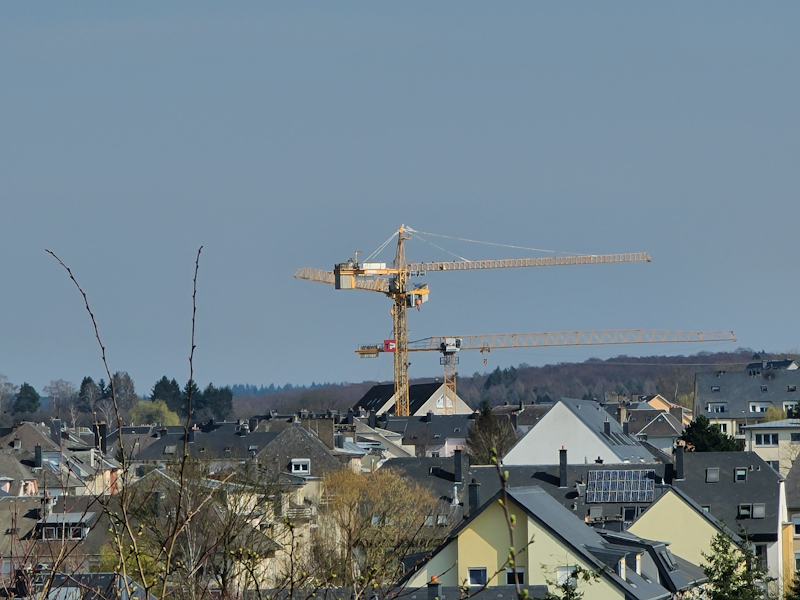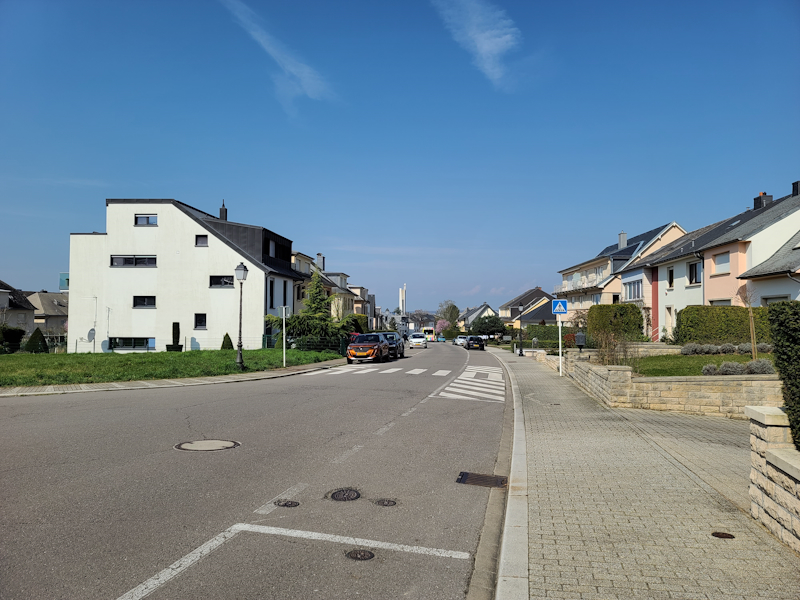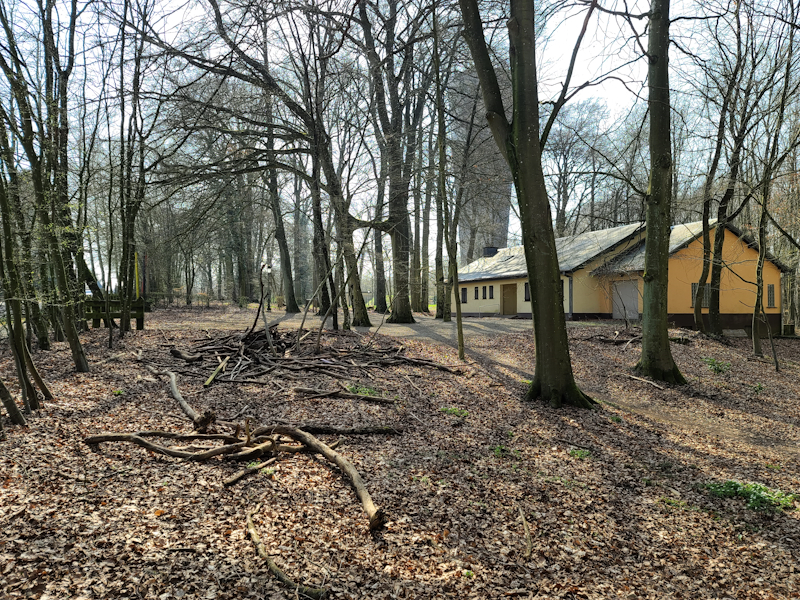The Samsung Galaxy S20+, S20 Ultra Exynos & Snapdragon Review: Megalomania Devices
by Andrei Frumusanu on April 3, 2020 9:30 AM ESTCamera: Daylight Evaluation: Far Sight
Naturally, the proof is in the pudding, and that’s where we’ll fully evaluate the S20 Ultras as well as the S20+. Last year we saw some larger camera quality differences between the Exynos and Snapdragon variants of the S10+; these differences slowly disappeared over the course of the year over numerous software updates, but there still remained some discrepancies here and there in terms of the software processing. This year, we’ll be putting the two S20 Ultras against each other in the same manner, and we also have the Exynos S20+ to check how that camera configuration compares.
I’ve noted that over the past years maybe I hadn’t been objective enough when it came to colour accuracy of the photo evaluations, so starting with the review today I want to do something else and add in another comparison point. The Fujifilm X-T30 with the standard 18-55mm kit lens will serve as a “reference” point in terms of the exposure and in particular the colour accuracy of the scenes – I particularly chose the Fuji because it had been praised as being amongst the best in the industry in this regard. The samples here are adjusted in terms of their exposure and dynamic range, but without any modification to the colour science.

[ Galaxy S20U - (S) ]
[ Galaxy S20U - (E) ]
[ Galaxy S20+ (E) ]
[ S10+ (S) ] - [ S10+ (E) ]
[ iPhone 11 Pro ] - [ Pixel 4 ]
[ Mate 30 Pro ] - [ P30 Pro ]
[ X-T30 ]
Diving right into the matter, let’s talk about the S20 Ultra’s zooming ability. Samsung here advertises up to 100x magnification, and I’ll pretty much discard this mode right out of the gate as being useless and a mere marketing gimmick. There’s essentially little to no advantage over a 30x magnification on the phone and it doesn’t even warrant samples as it just looks like a mess and no different than just magnifying the 30x shots digitally.
So, taking the 30x shots as the first comparison point, there’s only three phones in the line-up actually capable of such captures. Between the two S20 Ultra phones are very similar to each other, but there’s slight differences in terms of how they’re handling noise and sharpening. The Snapdragon unit has a bit more sharpening going for it but it’s hard to pick it as being outright superior. The S20+ is the only other phone capable to such magnification, and the difference to the S20 Ultras is quite large as there’s evidently a ton more pixilation and nowhere near the same spatial resolution – but that was to be expected.
At 10x magnification we again see the two S20 Ultra shots being similar in exposure, however there’s again differences in the detail. Here it’s more evident that the Snapdragon unit is using post-processed sharpening to the image, and there also appears to be some smearing of details as the Exynos unit does achieve to maintain some better textures on some elements.
Huawei’s P30 Pro and its own periscope telephoto module is the only unit that comes into play here as a competitor in terms of sharpness, but the S20 Ultras still beat it handily. The S20+ produces a useable result, but also lags behind the S20 Ultras – but is still far ahead of any other “conventional” zoom camera, with only the Pixel 4 competing in terms of result.
At 4x magnification which is the native level of the S20 Ultras, we again see the differences between the Snapdragon and Exynos units just pop right out at you, as the former’s sharpening is evident throughout the scene.
The S20+’s 3x result is the phone’s default mode when you tap on the telephoto zoom button when switching cameras, and the result does look respectable and is significantly more detailed than what you’d see from other 2-3x optical zoom modules, although the Mate 30 Pro’s 3x optics are much sharper, even if the sensor itself has some dynamic range issues.
At a 2x magnification, that’s where we see the S20 Ultra’s biggest weakness and problems. Samsung here is employing image fusion between the main and telephoto modules, using the sharper center image output of the telephoto module and merge it into the wider capture of the main unit. The problem here is that they’re doing this while the main module is at 12MP resolution, and the result is that the majority of the image looks like a pixelated mess as it has to do digital magnification on that 12MP image. It’s a massive disappointment and it’s here where the S20+’s dual-wide angle camera system comes to shine, as the 2x results is leaps and bounds better than on the S20 Ultras.
Not only are both S20 Ultras blurry here, but the Snapdragon S20 Ultra here goes haywire with the sharpening and the foreground vegetation is ridiculously over-processed, as if suffering from high image compression.

[ Galaxy S20U - (S) ]
[ Galaxy S20U - (E) ]
[ Galaxy S20+ (E) ]
[ Galaxy S10+ (S) ] - [ Galaxy S10+ (E) ]
[ iPhone 11 Pro ] - [ Pixel 4 ]
[ Mate 30 Pro ] - [ P30 Pro ]
[ X-T30 ]
In the next scene, again we see the two S20 Ultras dominate in terms of their sharpness and what they’re able to achieve, being far ahead of any other phone in terms of the achieved resolving power at high magnification.
The two Ultras again showcase big troubles at 2x magnification and are handily beat by every other phone in the line-up, even losing to last year’s S10.
Between the Snapdragon and Exynos S20U’s, the Qualcomm variant continues to showcase more post-processed sharpening throughout the scene on all camera modules. On both wide and ultra-wide shots, we see the Exynos able to retain better definition of textures in the brighter elements on the scene such as on the small and big concrete towers.

[ Galaxy S20U - (S) ]
[ Galaxy S20U - (E) ]
[ Galaxy S20+ (E) ]
[ Galaxy S10+ (S) ] - [ Galaxy S10+ (E) ]
[ iPhone 11 Pro ] - [ Pixel 4 ]
[ Mate 30 Pro ] - [ P30 Pro ]
[ X-T30 ]
The S20 Ultra’s telephotos are again quite incredible for a phone – far ahead of any other phone and handily beating my X-T30 on the regular kit lens. While the Snapdragon does pop out more and has more contrast in the details, it’s quite exaggerated and doesn’t feel as natural as the unsharpened results of the Exynos S20U.
On the main and ultra-wide, these differences continue. Vegetation might look more pronounced on the Snapdragon, but it loses out in texture retention to the Exynos throughout the scene.
This scene for some reason was very wrongly exposed on almost all the phones, with all of them getting a failing mark in that regard. Even though it’s in broad daylight, the S20 results barely have any elements in the upper 10-15% of the histogram in terms of exposure levels, the X-T30 better represents the scene as it was in reality.

[ Galaxy S20U - (S) ]
[ Galaxy S20U - (E) ]
[ Galaxy S20+ (E) ]
[ Galaxy S10+ (S) ] - [ Galaxy S10+ (E) ]
[ iPhone 11 Pro ] - [ Pixel 4 ]
[ Mate 30 Pro ] - [ P30 Pro ]
[ X-T30 ]
In the next shot there’s some issues that start arising for the S20+’s “telephoto” module, and that’s the optics. In this scene with an extremely bright backdrop against the sun with very high contrast due to the trees, we see very a very prominent haze around the high contrast elements. It’s as if the phone had a smudged lens, but it was actually clean. I noticed this happens in quite a for scenes for the S20+ and the only explanation I have is that it’s an optics issue with the lenses of this module.
This is also a good scene to start talking about the 108MP capture modes of the S20 Ultras. There’s a massive amount of detail here and these particular samples are around 50MB in size, as a warning before you open them.
Both phones are able to capture significantly more detail than in their default 12MP modes, however there a very stark differences between the Snapdragon and Exynos phones, with the latter being able to produce a much higher quality result with far more natural detail. I don’t know exactly what’s happening here, but it’s as if the Snapdragon picture was lower resolution and scaled up to 108MP, whereas the Exynos unit is closer to a native resolution shot.
Although there’s haze in parts of the shots, the 64MP shot of the S20+ here is doing a remarkable job in terms of keeping up with the 108MP cameras, and I’d even go so far to say that for large parts of the scene it’s actually able to resolve things with more spatial resolution than the S20 Ultra, particularly towards the edges of the scene where the Ultra just starts getting far too soft.

[ Galaxy S20U - (S) ]
[ Galaxy S20U - (E) ]
[ Galaxy S20+ (E) ]
[ Galaxy S10+ (S) ] - [ Galaxy S10+ (E) ]
[ iPhone 11 Pro ] - [ Pixel 4 ]
[ Mate 30 Pro ] - [ P30 Pro ]
[ X-T30 ]
This is another incredibly detail-rich scene, this time around with also more high dynamic range.
The S20 Ultras are quite different here in terms of their color renditions, with the Snapdragon being quite saturated. There’s also differences in exposure – although both phones were similar in their exposure time at 1/124 and 1/135th second, the Snapdragon chose ISO16 while the Exynos chose ISO50. There is some evident change in the HDR processing as the Exynos is able to better preserve the highlight of the sky and that part of the trees whereas it’s blown out on the Snapdragon.
The S20+ feels weird here on the main sensor as it produces a seemingly lower resolution image on the right side of the creek, with worse results than that of the S10 and other phones.

[ Galaxy S20U - (S) ]
[ Galaxy S20U - (E) ]
[ Galaxy S20+ (E) ]
[ Galaxy S10+ (S) ] - [ Galaxy S10+ (E) ]
[ iPhone 11 Pro ] - [ Pixel 4 ]
[ Mate 30 Pro ] - [ P30 Pro ]
[ X-T30 ]
The flower here is again a good example of the haze that’s present on the S20+’s 64MP lens module, again showing some weak optical characteristics.
When taking pictures of more close-up objects, the S20 Ultra’s huge sensor and shallower depth of field becomes more apparent as the background becomes significantly more out of focus and blurred out. The problem is that isn’t not so much a smooth bokeh more appears more as chromatic aberrations and quite a bit of a mess.
The phones are also having trouble with the exposure and HDR and highlights of the vegetation is far too bright, the Pixel 4 and iPhone 11 Pro are doing a much better job here.










137 Comments
View All Comments
crimson117 - Friday, April 3, 2020 - link
$1400 is absurd. There's no way they're worth more than twice as much as a brand new S10.Andrei Frumusanu - Friday, April 3, 2020 - link
Probably one of the reasons Samsung still continues to sell the S10 series. They're really excellent value right now, and you're not missing out on too much.cha0z_ - Monday, April 6, 2020 - link
You are literally getting just one more year of software support going for s10 series... samsung software support policy is abysmal with less than two years of real support and from there just security. I got both iphone 11 pro max and exynos note 9, if I put aside the cr*ppy 9810 - it will not receive even the oneUI 2.1 as an update, while samsung will soon release it for s10 line. Enough said, note 9 is year and a half old.How can you recommend someone 1000 euro or 1400 euro phone if it will be supported for 1.5 years and from there 1.5 more security updates next to apple with 5 years FULL support with major, minor, day one, betas + security update for old iphones like 4s and 5 (2011 and 2012 respectably)?
goatfajitas - Monday, April 6, 2020 - link
You do realize the phone doesn't stop working when it doesn't get an OS update right? TBH, neither Android or IOS has added a whole lot in the past few years, its just a yearly cadence of very minor updates and not getting them means almost zero in actual use.Featherinmycap - Monday, April 6, 2020 - link
I think there have been a lot of added features to IOS in the last 3 years that I use a great deal. Not saying that Android didnt already have some of these features, but for IOS users we got with IOS 11; a file manager (finally), Messages sync with iCloud, screen recording, useful improvements to Siri and ApplePay. IOS12; lots of performance improvements (lots), Screentime, Shortcuts (scripting), CarPlay, Animoji Memoji, Tracking prevention, IOS13; Single Sign on, external storage, Dark Mode, better support for keyboards, trackpads/mice, etc.Famorcan007 - Tuesday, April 7, 2020 - link
I think it's because Android mostly has offered those features(file manager,screen recording, external storage,support for mice etc.) since way back compared to iOS' slow but steady trickle of features that's why iOS users feel every OS update is huge and significant. I'm using a Note 4(my backup device) right now to comment which doesn't feel too crippled compared to my Android 9 P20 pro.cha0z_ - Tuesday, April 7, 2020 - link
Let's not find an excuse - software support is software support. Security is security - some of us keep all their personal info on their device (most of us) + bank accounts and whatnot, risking compromise on your phone is not that innocent compared to what was like back in the days. IOS adds rapidly more features for sure compared to android that recently starts to look more and more like IOS (and I personally totally don't like that), but still added some good stuff under the hood and some new features.It's not serious to sell 1400 euro phone that is supported for one year and a half. I own exynos note 9 - it's 1.5 years old and already samsung dropped the support, s10 line received oneUI 2.1, note 9 will not. How is that for my 1000 euro phone + double served with that cr*ppy exynos 9810 in it. Now it's in my GF and I am rolling iphone 11 pro max. I prefer android and love oneUI, but I am tired to be a second hand customer.
s.yu - Tuesday, April 7, 2020 - link
Don't know what you're talking about. My Note8 just got another update days ago, one that I preferred not to have because each update comes with a risk of bricking the device while potential changes to the UI are not always welcome either. I also got it ~30% off retail a few months after release, such has always been the state of Samsung, at least for S and Note.I'm no longer buying Samsung but the main reason is lack of the 3.5mm port, if I have to name another then it's between the questionable choice of telephoto in the smaller variants or the oversized device with a mediocre battery(I regard 5000mah to be mediocre for the size). I still do like the UI but I'm willing to look around.
Psyside - Tuesday, April 7, 2020 - link
"It's not serious to sell 1400 euro phone that is supported for one year and a half. I own exynos note 9 - it's 1.5 years old and already samsung dropped the support, s10 line received oneUI 2.1, note 9 will not. How is that for my 1000 euro phone"Very easy, with those "very old software features" Samsung can do what MAC can't, and don't get me start it on the utter crap IOS.
Also don't spin it, Samsung offer 4 (four) years of security updates, so do your research before you type something.
cha0z_ - Wednesday, April 8, 2020 - link
fanboy. Security update hahahahah iphone 4s and 5 still receives security updates - 9 years old phone for 4s. What you will say now?iphone receive FULL support with MAJOR ios versions, updates, minor updates, BETA versions, DAY ONE as their newest and most expensive phone - for 5-6 years and you are talking about 4 years of security updates roflmao. Samsung released note 9 with android 8 when android 9 was already released from more than a months. Oooo, it's enough time, because you can dev your skin and features on top of the dev previews, especially the later ones that are closer to final (for the more tricky/deeply integrated code) - so no excuse for what they did. Basically they gave me one major update - android 10 as android 9 should had been on the note 9 from the start. Even if we count 2, how is that next to 5-6 versions of ios?
And before you talk some more fanboy bs that never used recent years iphones - ios brings a lot more in every new versions (adding features that was missing for no reason, like external USB flash support, file browser for the files on the phone, etc) while android 10 brings you what? More lockdown ios style, iphones gestures and pixel device that is a cheap iphone wannabe.
Because of people like you samsung don't want to change their software support policy. Why should they? It costs money or now you will start with the argument how the phone hardware is not supporting oneUI 2.1 (for the note 9 that is 1.5 years old, but will not receive it most likely ;) ). Or maybe android 11 will be too much for the phone, right? :D
Also I agree - my note 9 can do more than my iphone 11 pro max, but everything that the phones do both (and that's 99.9% of what you will end up using constantly) - the iphone 11 pro max makes the exynos note 9 look like a total utter joke - faster, smoother with NOT A SINGLE frame drop no matter what you do, gaming is insanely good with surprise - NOT A SINGLE frame drop, battery life is x3 times better, apps have MORE features and runs super smooth and great, speakers destroys the note 9 one, camera too is times better, materials are a lot better too, faceid is super good and fast - feels like I don't have any security on - never failed or gave me any issue. Fun fact, note 9 came with fortnite and recommended as gaming phone for that game. My exynos variant can't run smoothly the game even with 30fps cap medium settings and !1080p! while iphone XS max runs it 60fps high 2688x1242 without a single frame drop. Same goes for the 11 pro max, obviously.
As for ios - it improves massively and adds more and more missing features/drops restrictions with every version. ios 14 is already known to drop more. I prefer android, because I can do more + I love oneUI, but that doesn't change the fact that in my country I will receive exynos and 1.5 years of decent support. And in the end of the day - I spend my time in apps, not in the settings menu and apps on ios are better, with more features, smoother, a lot of them exclusive to the platform. Can you play dead cells on your android device? No? Yeah, the port is expected around the end of the year, I have it from June 2019. Full blown civilization 6 on your android device? Yeah, will never come, I have it and it's 1:1 port that runs great. Can go on and on and on. If you spend your time tweaking settings, options, UI - good for you, I spend my time in games and apps.